
Pamukkale

Pamukkale, meaning "cotton castle" in Turkish, is a natural site in Denizli Province in south-western Turkey. The city contains hot springs and travertine terraces of carbonate minerals left by the flowing water. It is located in Turkey's Inner Aegean region, in the River Menderes valley, which has a temperate climate for most of the year.
The ancient city of Hierapolis was built on top of the white "castle" which is in total about 2,700 meters (8,860 ft) long, 600 m (1,970 ft) wide and 160 m (525 ft) high. It can be seen from the hills on the opposite side of the valley in the town of Denizli, 20 km away.
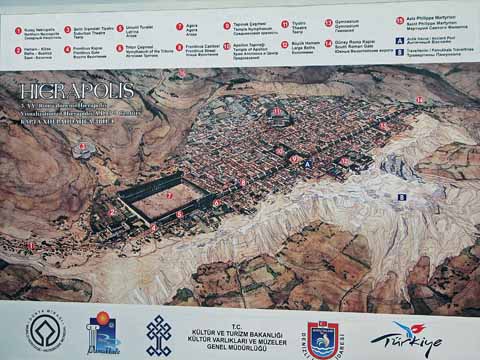
The city, which was founded on this site in the 2nd century
B.C., differs from all other ancient cities in being located, not on earth or
rock, but on solid limestone layers formed by limestone water that flowed for
centuries over this raised level plateau.
"Hierapolis" can mean "sacred city", and
according to Stephanus of Byzantium the city was given this name because of the
large number of temples it contained.
Up to the reign of Augustus the city was officially described on coins as Hierapolis, the city of temples, but it seems reasonable to assume that this was not the original meaning of the name.
Tourism is and has been a major industry. People have bathed in its pools for thousands of years. As recently as the mid 20th century, hotels were built over the ruins of Heropolis, causing considerable damage. An approach road was built from the valley over the terraces, and motor bikes were allowed to go up and down the slopes. When the area was declared a world heritage site, the hotels were demolished and the road removed and replaced with artificial pools. Wearing shoes in the water is prohibited to protect the deposits.
The
ancient city of Hierapolis was built on top of the white "castle"
which is in total about 2,700 metres (8,860 ft) long, 600 m
(1,970 ft) wide and 160 m (525 ft) high. It can be seen from the
hills on the opposite side of the valley in the town of Denizli, 20 km
away.
In
this area, there are 17 hot water springs in which the temperature ranges from
35 °C (95 °F) to 100 °C (212 °F). The water that emerges
from the spring is transported 320 meters (1,050 ft)] to
the head of the travertine terraces and deposits calcium carbonate on a section
60 to 70 meters (200 to 230 ft) long covering an expanse of 240 meters (790 ft)
to 300 meters (980 ft). When the water, supersaturated with calcium
carbonate, reaches the surface, carbon dioxide gases from it, and calcium
carbonate is deposited. The depositing continues until the carbon dioxide in the
water balances the carbon dioxide in the air. Calcium carbonate is deposited by
the water as a soft jelly, but this eventually hardens into travertine.
This
reaction is affected by the weather conditions, ambient temperature, and the
flow duration. Precipitation continues until the carbon dioxide in the thermal
water reaches equilibrium with the carbon dioxide in the atmosphere.
Measurements made at the source of the springs find atmospheric levels of 725 mg/l
carbon dioxide, by the time this water flows across the travertine, this figure
falls to 145 mg/l. Likewise calcium carbonate falls from 1200 mg/l to
400 mg/l and calcium 576.8 mg/l to 376.6 mg/l. From these results
it is calculated that 499.9 mg of CaCO3 is deposited on the travertine for
every liter of water. This means that for a flow rate of 1 ı/s of water
43191 grams are deposited daily. The average density of a travertine is 1.48
g/cm3 implying a deposit of 29.2 dm3. Given that the average flow of the water
is 465.2 l/s this implies that it can whiten 13584 m2 a day, but in practice
this aerial coverage is difficult to attain. These theoretical calculations
indicate that up to. 4.9 km2 it can be covered with a white deposit of 1 mm
thickness.
Pamukkale
is one of Turkey’s incomparable natural wonder with the calcium cascade
terraces of snow white stalactites and is known as 8th wonder of the World by
Turkish people. Pamukkale & Hierapolis together are both recognized as
UNESCO World Heritage Sites since 1988. They have all the conditions required
for an ideal tourist resort. Pamukkale is very well known with the entrancing
beauty of its unique geological formation and also with its historical remains.
The white cotton-like terraces are mineral deposits which come from Cal
Mountain’s rich spring waters and volcanic springs that were saved since
thousand years. The water runs down the travertine and fill them up with water
and there is a pool where you can have a chance to swim among the ancient Roman
columns.
It has 14,000 year-old existence. To keep the travertine white and to prevent crush and damage on them, in 1997 it
was forbidden to walk on them and the water is allowed to reach the terraces
periodically according to weekly watering schedule. But it is possible to walk
on the south part of the travertine with naked foot.
~ ~ ~ ~ ~ ~ ~ ~ ~ ~ ~ ~ ~ ~ ~ ~ ~ ~ ~ ~ ~ ~ ~ ~ ~ ~ ~ ~ ~ ~ ~ ~ ~ ~ ~ ~ ~ ~ ~ ~ ~ ~
Before we start for Heirapolis, we sail into the port city of Izmir - Smyrna
İzmir has almost 3,500 years of recorded urban history and possibly even longer as an advanced human settlement. Lying on an advantageous location at the head of a gulf running down in a deep indentation midway on the western Anatolian coast, the city has been one of the principal mercantile cities of the Mediterranean Sea for much of its history.
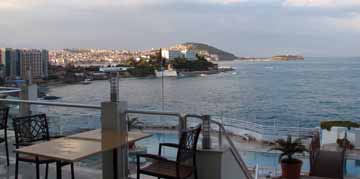
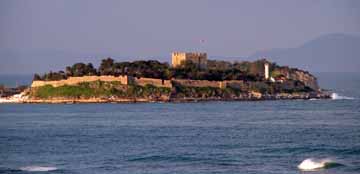
A Crusader Castle on a small island off the port

On the road to Izmir
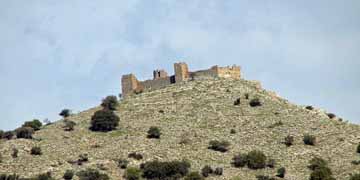 Another Crusader
fortress
Another Crusader
fortress
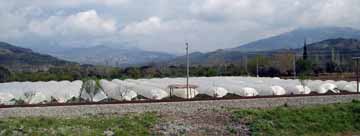
A rich agricultural area, there seems to be miles of crops under plastic covers

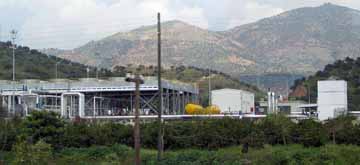
A very active geothermal area, there are plants such as this using geothermal resources to heat towns and generate electricity.
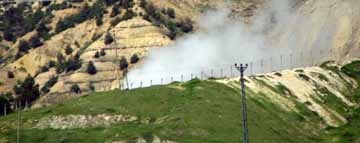 Steam simply escapes from the earth in
Steam simply escapes from the earth in
several places.
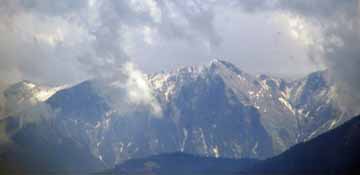 Ah,
the mountains boarder the plateau
Ah,
the mountains boarder the plateau

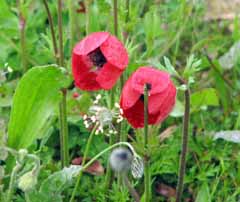
Love the flora
We're here!

We enter through South Gate
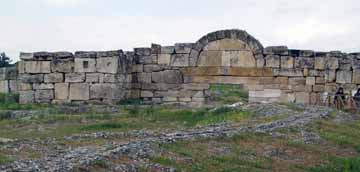

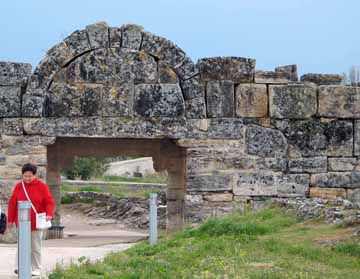
There are these troughs all through the area - meant to carry water
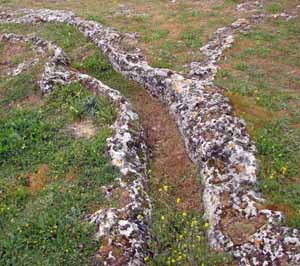

Bath houses are in several locations
City ruins are found over a huge area
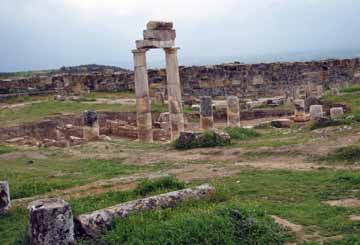
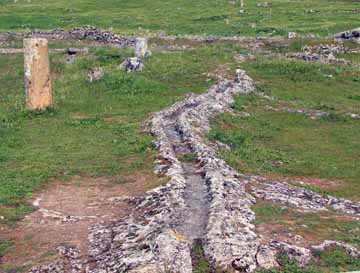
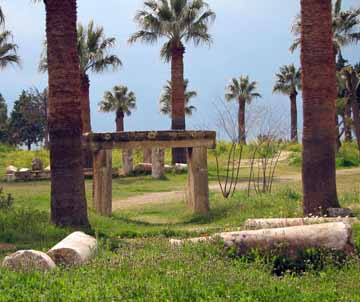
THE
ROMAN THEATER
It is located in the middle of Hierapolis and is very well preserved. it was built during the reign of Emperor Hadrian in 2nd century AD. In Emperor Severus period the cavea and the stage of theatre were restored by using the remains of another old theatre built earlier on the north of the city. Roman Theatre had a capacity of 8500 – 10000 spectators and was divided into two parts as upper and lower parts of seat by a diazoma. People arranged concerts, religious ceremonies, competitions in this theatre. In the friezes of the theatre some mythological scenes had been depicted.
The first theatre was constructed to the northeast above the northern gate, when the ancient city was destroyed by earthquake in 17 CE.
After the earthquake of 60 CE and during the reign of emperor Titus Flavius Vespasianus a new theatre was hollowed out of the slope of the hill further to the east, using the remains and the seats of the old theatre. There were alterations during the reign of emperors Hadrian and Septimius Severus. In 352 CE it underwent a thorough restoration and was adapted for water shows.
There is an inscription in the theatre that relates to the emperor Hadrian. Emperor Septimius Severus is portrayed, together with his wife, Julia domna, and his two sons, in a relief on the scene of the god Jupiter, who is shown seated on his throne. Emperor Septimius Severus also had a number of new buildings constructed in Hierapolis in gratitude for the sophist Antipater of Heirapolis, his private secretary and the tutor of his two sons.
The were four entrances to the theatre, each with six statues in niches, flanked by marble columns. The auditorium consists of stacked seating with a capacity of 15,000 and is divided in two by a horizontal corridor and featured an imperial box. The lower part originally had twenty rows, and the upper part twenty five rows. But only thirty rows altogether have survived.
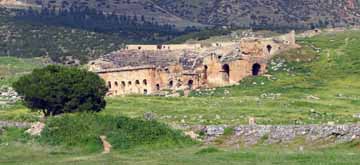

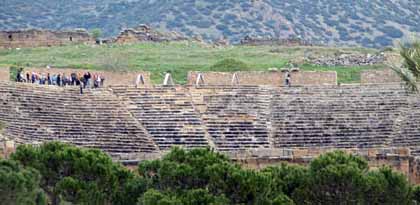
TEMPLE OF APOLLO
Apollo was the most important god for local people. An honorary temple was built in front of the theatre for him. Because of the rock mass at the back of the temple which was excavated it assumed that there were large steps to reach the temple of Apollo.
Doric style marble columns which have higher quality than main street columns
were used for the temple. Local people believed that Apollo and Artemis met
here.
A prediction center and the gate to the hell have been also found near the
temple.
Here is the oldest place worshipped by the local people in Hierapolis ancient city. Local people call here as a demons hole. The temple of Apollo was built beside of it because plutonium had religious importance.
This hole is large enough to be entered by a person. The poisonous gas (Carbon
Dioxide) comes out from plutonium and it was believed to be sent by Pluto, the
god of under world. Birds and oxen that approached to plutonium died
immediately.
The religious men mentioned to the local people that they were created in a
superlative position because they entered to hole by a breath control and came
out of it alive. So all locals believed and obeyed them.
I must confess that I probably have a picture of an ruin that is not the Temple of Apollo - however I'll stick with this until corrected.

 A
number of beautiful statues adorn the ruins
A
number of beautiful statues adorn the ruins
MARTYRIUM
This
martyrium which is an octagonal structure and has a square base is a monument of
Saint Philip.
Saint Philip was one of the twelve apostles of Christ and he was martyred in
Hierapolis in 80 AD. Monument was built in the 5th century AD. He and his
daughter contributed greatly to the spreading of Christianity in Hierapolis.
Saint Philip Martyrium is another sign of the influence of Christianity in the
city. It was not a church but was used for religious ceremonies.
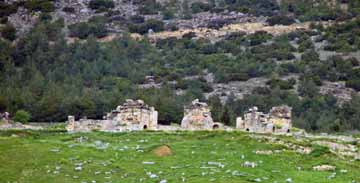
I'm forced to admit I cannot find in my notes or in research just exactly what these massive ruins are. I'm tempted to think they are part of ancient baths or part of the library - but I just don't know. A shame as the pictures are fairly good.
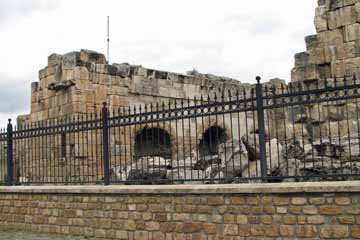
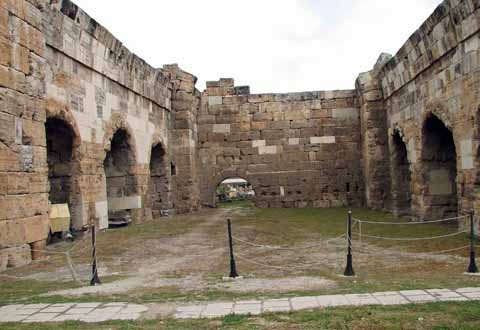

Other picturesque ruins surround you as you walk the area.
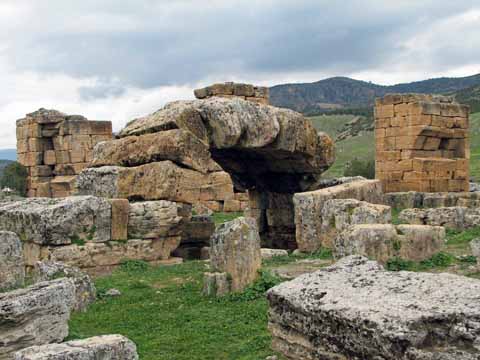
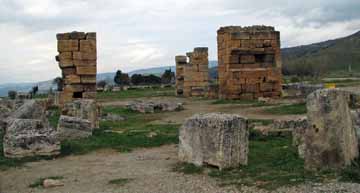
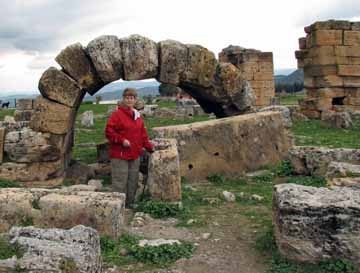
The Bath
In
ancient times all religious buildings were built nearby hot or cold water
sources.
Beside religious buildings, some other buildings such as fountains and baths
also were built for curing. The numbers of baths, fountains and also churches
are evident of the importance of waters in Hierapolis and Christianity. The temples were significant
trade centers and Hierapolis had many temples that made people confused about
which god they would worship before Christianity.
Hierapolis means “Holy City”
because of its religious importance and also temples together with other
religious buildings.
The ancient city of Hierapolis was settled in an area of 1000 x 800 m. Hierapolis had many destructive strong earthquakes and as a result, each earthquake razed the city. (First destructive one in 17 AD, second one in 60 AD, third and last one in 1354)
Visitors swim, soak and drink every day in the antique pool.
Especially in The Roman Empire period, Hierapolis and its side was exactly a health centre. In those years, thousands of people used to come to the baths, of which there are more than 15, and they found their remedy in those baths. Today’s Antique Pool was shaped by the earthquake which happened in the 7th century AD. The marble portico with Ionic arrangement fell into the spring during the earthquake in the 7th century.
According to research, the Antique Pool's water is good for heart diseases, atherosclerosis, blood pressure, rheumatism, eye and skin diseases, rickets, nervous disorders, nervous and physical exhaustion circulatory problems and furthermore when it has been drank it is good for digestive maladies. And all this benefits shows why so many health centers had been founded sides the Antique Pool from Roman Empire times on.
The water in the thermal pool is 36-57 C°, pH value is 5,8 and radon value is 1480. Spa water has its bicarbonate, sulphate, carbon dioxide, partly with iron and radioactive combination. And also, the water in this spring is suitable for taking shower and drinking cures, 2430 MG/liter melt metal value.
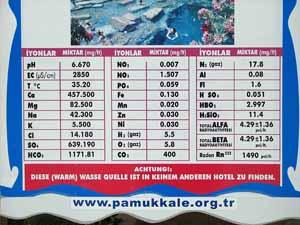
The chemical compounds found in the pool waters

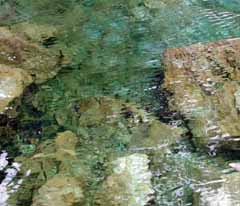
It was very difficult for me to get suitable pictures of the pool as I had not brought my polarized lens along. I hope you can look carefully to see swimmers / soakers and the ruins in the pool from the 7th century earthquake.
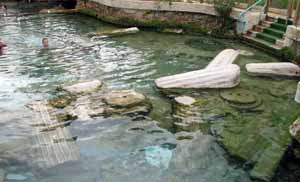
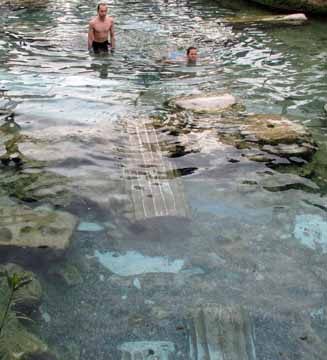
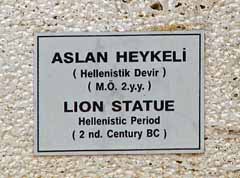
Statues just outside the antique pool
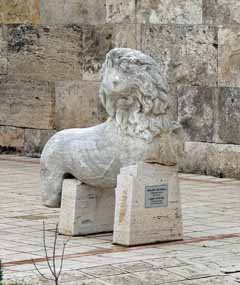
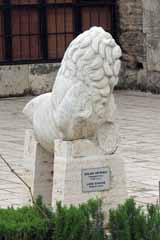
The World Famous Travertine Terraces
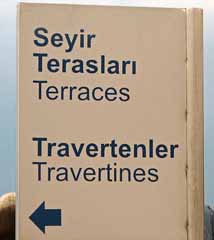
There's not a lot I could say about the terraces! I mean, what can you say? They are beautiful, seem to go on for thousands of feet, both wide and deep, and contain incredibly clear, blue water over blindingly white travertine.

As recently as the mid 20th century, hotels were built over the ruins of Heropolis, causing considerable damage. An approach road was built from the valley over the terraces, and motor bikes were allowed to go up and down the slopes. When the area was declared a world heritage site, the hotels were demolished and the road removed and replaced with artificial pools. Wearing shoes in the water is prohibited to protect the deposits.
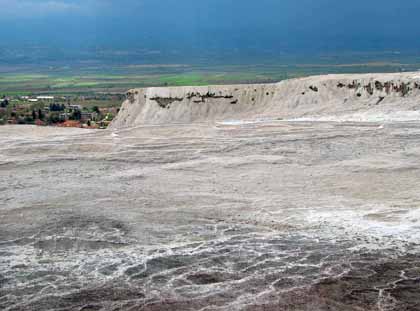
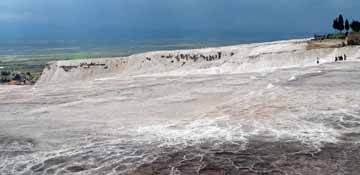
Pamukkale's terraces are made of travertine, a sedimentary rock deposited by water from the hot springs. In this area, there are 17 hot water springs in which the temperature ranges from 35 °C (95 °F) to 100 °C (212 °F). The water that emerges from the spring is transported 320 metres (1,050 ft)to the head of the travertine terraces and deposits calcium carbonate on a section 60 to 70 metres (200 to 230 ft) long covering an expanse of 240 metres (790 ft) to 300 metres (980 ft). When the water, supersaturated with calcium carbonate, reaches the surface, carbon dioxide degases from it, and calcium carbonate is deposited. The depositing continues until the carbon dioxide in the water balances the carbon dioxide in the air. Calcium carbonate is deposited by the water as a soft jelly, but this eventually hardens into travertine.

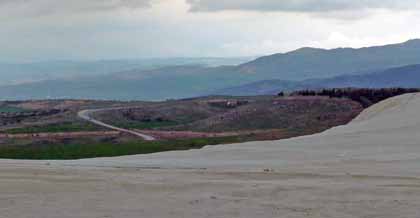
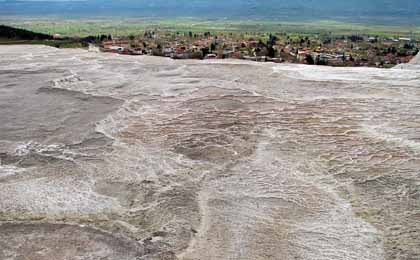
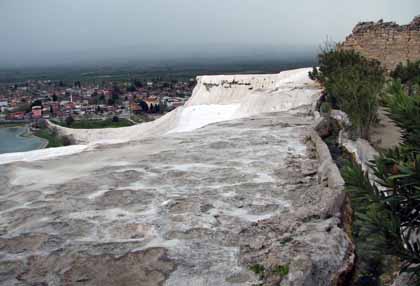
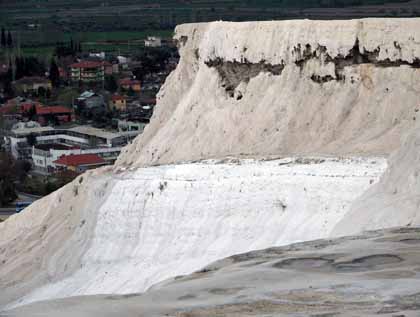
As you see, people can walk on the terraces from certain points. However, no-one may wear shoes - one must be barefoot or in socks. I didn't try it, but a number of our group did.

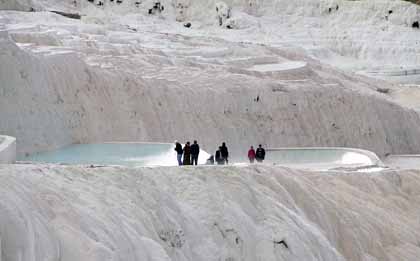
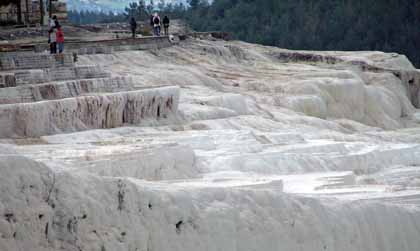
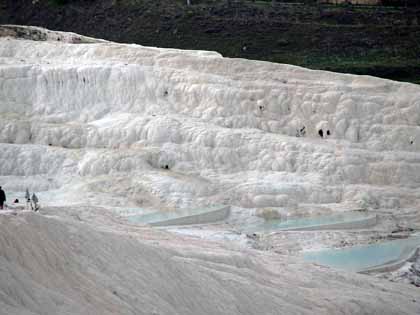

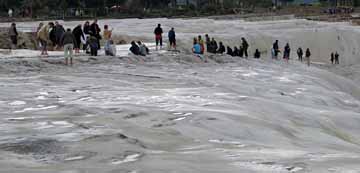
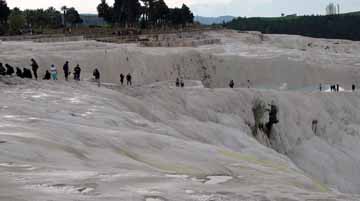
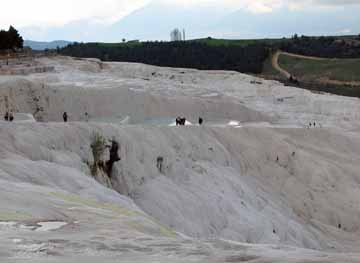
The terraces are bordered by countryside growth and greenery. It looks especially green and pretty after looking at the stake white of the terraces.

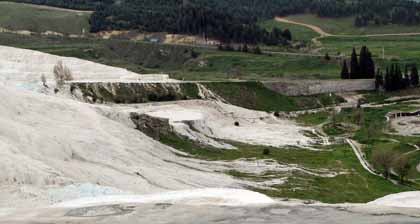

There is a small town below - where all of the hotels and business were relocated from a top the terraces. The town looks almost alpine from where we stand at the top of the terraces.

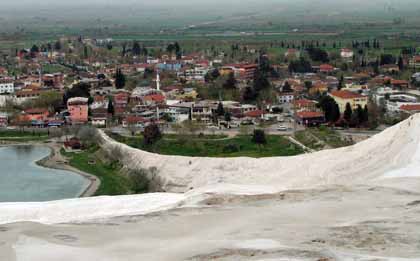
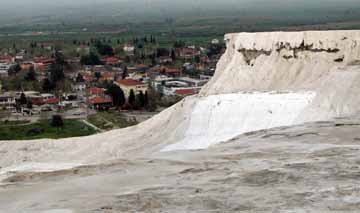
The water is allowed to run one different sections of the terraces each day. This allows a uniform build up of the travertine and keeps the whole of the terraces white. A small stream of the perfectly clear water runs through these troughs.

Steps formed by the terraces.
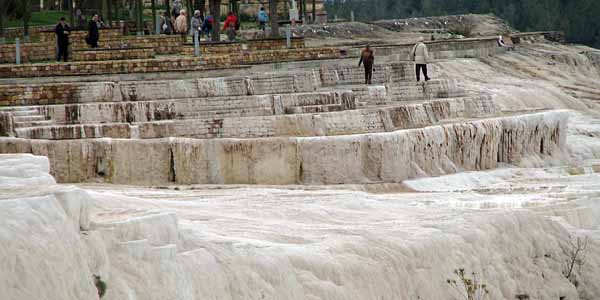

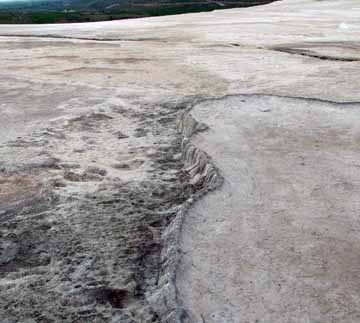

How can you not take too many pictures????
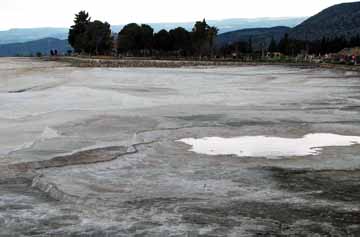

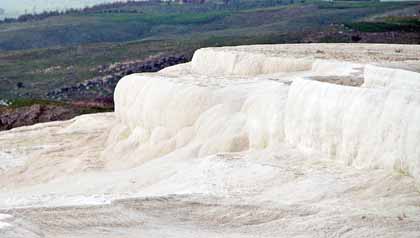


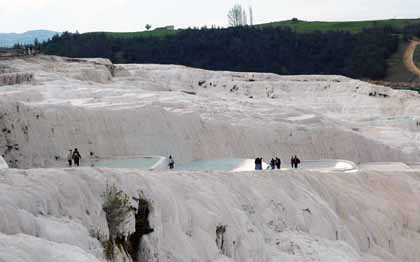

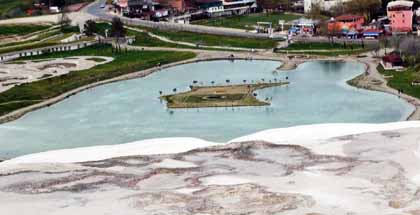
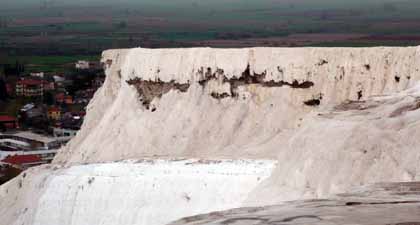

The bathroom meeting
After walking the terraces, we started down the road to the Necropolis. I don't think you can possibly see the really ugly weather that was building. We hoped it would pass us, but unfortunately just above the Necropolis a tremendous thunder storm broke out.
Jackie & I ran to the nearest building - a men's bathroom. And we were not alone. Another couple had entered just before we got there and we were joined by as many as four other women. So, two men and may six women huddled in the men's room while peaking out to see if a van hauling tourists was coming down the road.
We saw a van and ran out - but it wasn't a tourist van - I think it was a employee van. None-the-less, he stopped and like soaked sheep we all jumped in. Very kind of the young man and saved us a couple dollars in fares.
The result is we missed a large amount of the lower ruins and nearly all of the Necropolis. The few pictures I got were after we reached the end of the trail and the rain stopped.
A shame to have missed so much.
NECROPLIS
Necropolis
means cemetery. In Greek language it means city of dead. Necro : dead, polis :
city. Necropolis is a large burial site generally it was located outside the
settlement.
Hierapolis cemetery is one of the widest cemeteries in Anatolia. It has three
different parts, north, south and west. The north one is the largest one in
Hierapolis with more than 1200 graves. Graves in Hierapolis necropolis have
suitability for the social class of the dead.
There are 4 different types of graves here and belong to the late Hellenistic,
Roman and Eastern Roman periods. Hierapolis was not very big settlement in
itself but it has huge necropolis lands because it was a holy city and old
people used to come to benefit from the thermal baths and spend their last days
here and many of them died and buried here. In addition some people who lived
nearby were also buried here on their own wishes.
Tumulus Graves: They have a round plan and very large. They are mound raised
over a grave. Inside of them there are grave rooms and it is possible to enter
this inside rooms with a small doors. Tumulus type graves look like small hill.
Sarcophagus: All sarcophagus type of graves was made from marble because they
were belonging to the upper social class such as riches, heroes, noble people
etc and they were large decorative coffins. It means in Greek “flesh
eating”. Sarcophaguses stand on ground, on a podium, or on top of a cell.
Public Graves: Public graves were underground and made for the ordinary people.
They had box shape.
Family type graves: According the number of the persons in the family, largeness
of the family type grave changes because these graves were made for all
individuals of a family. Mostly they have several rooms, roofs and also windows.
Among these all types just sarcophaguses were made from marble all others made
from limestone. Each tomb has an inscription about name and life of the deceased
and also social clubs in the city and their activities are mentioned.

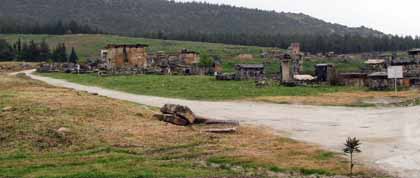
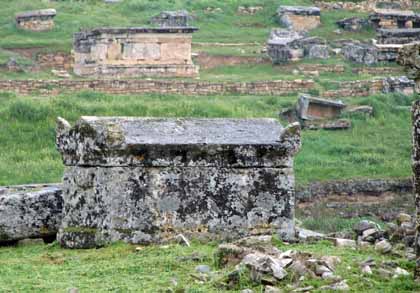
Just beyond the Necropolis and before the tourist center, there was the group of Red Buds. I was informed by an employee in the tourist center that the Turks call them Jesus Trees. The legend is that at one time all such trees were white. But on the day Jesus was crucified, they are turned red.
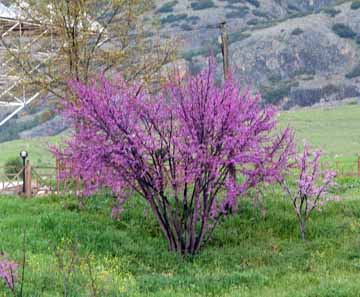
We spent the night in a hotel / spa. Each room had a tub with three (3) handles for spigots. One was for cold water, one was for hot water, and one was for the water from the mineral spring.
As one walked to the restaurant for dinner, one walked past the swimming pools. A you see, they were fed by the mineral springs. The steam rose from the spring and as it ran over a small waterfall into the poll it created stalactite (stalagmite ?) type features which, like the terraces, were formed as travertine.

The hot mineral water issuing from the spring.

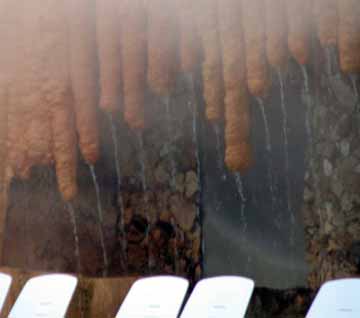
In the center of town there was a traffic circle - in it was another hot spring.
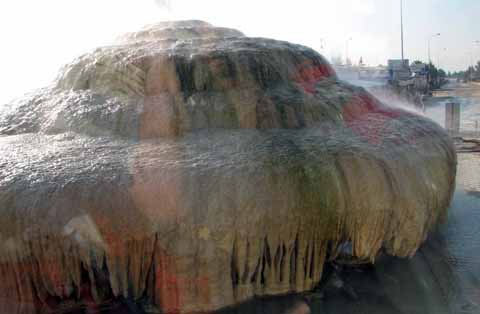
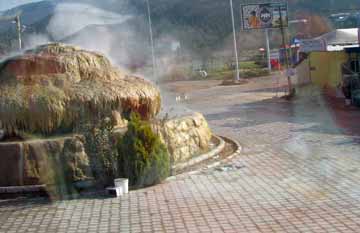
As we left the next morning, we stopped to see the terraces from below, at town level. There was also a beautiful small park to walk around.
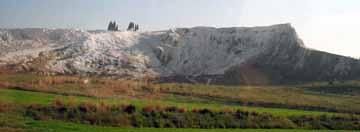
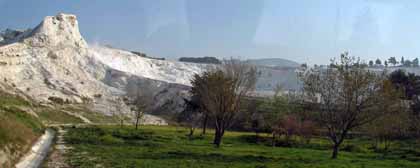


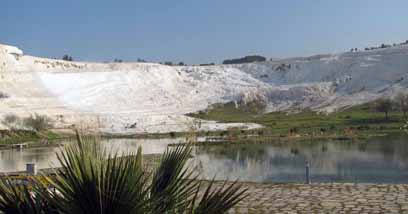
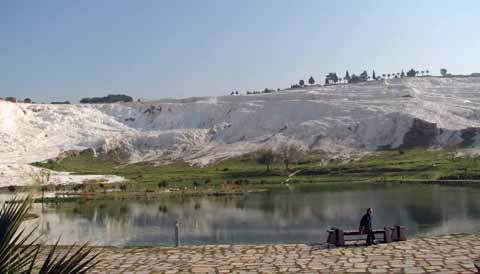

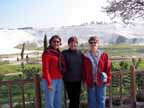

So we leave this World Heritage site and head for Antalya.
 Again
- Ah, the mountains
Again
- Ah, the mountains
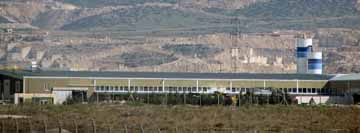
In addition to the geothermal industry, there is heavy mining and quarrying in the area.
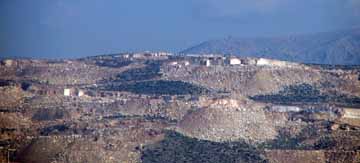
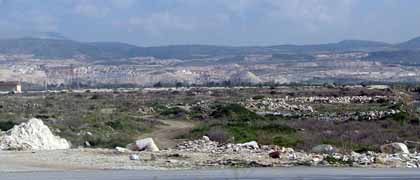

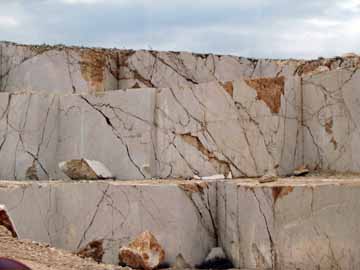
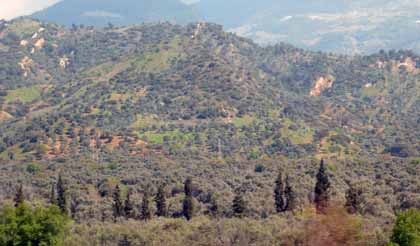 We pass hill sides and
smaller towns
We pass hill sides and
smaller towns
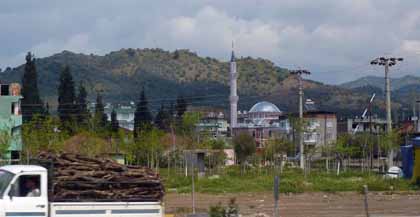
 Smoke
or steam? My guess - steam.
Smoke
or steam? My guess - steam.
Saltwater
lakes
Most
of the lakes in Turkey are fresh water lakes, but few of them have bitter waters
or salty waters. The biggest salt lake is Lake Tuz, which literally means
"Salt Lake" in Turkish. Tuz Lake and other salty lakes such as
Karapinar and Palas are the main centers of salt production in Turkey.
Tuz Golu, in
Turkish, is a saline lake occupying a huge area in the arid central plateau of
Turkey, about 65 miles (105 km) northeast of Konya, neighboring also Nigde and
Ankara provinces. It's the second largest lake of Turkey, after Lake Van. For
most of the year is very shallow (between 0,5-1 meters), especially during dry
summer months when the water evaporates in huge quantities leaving a tick crust
of salt on the surface up to 30 centimeters. This salt is extracted, worked,
refined and sold in the local market, thus making this the biggest industry for
small towns' economy in the area. It's not only the biggest salt lake of Turkey,
but one of the biggest in the world as well. The lake has no outlet, and only
few surface streams feed it but they dry in the summer when the climate is hot.
Rainfall in the surrounding area is as low as 10 inches (250 mm) per year.

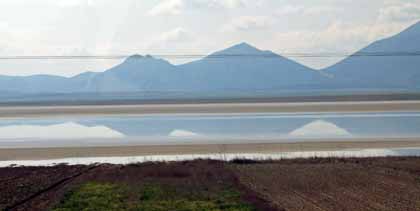 In
places the water is so smooth the reflections of the bordering mountain are unmistakable.
In
places the water is so smooth the reflections of the bordering mountain are unmistakable.
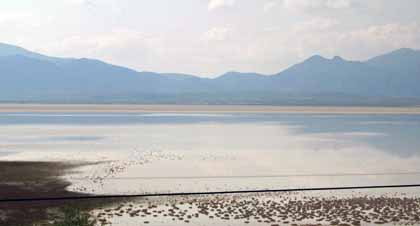
The lakes are a prime source for salt. Do not be fooled by the size of the lake. While, as we are in the distance and in a bus, if you look carefully you will see steam shovels digging the salt and placing it in tractor trailers. Both shovels and trucks a full size!
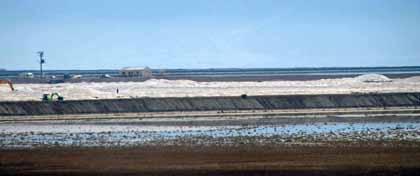


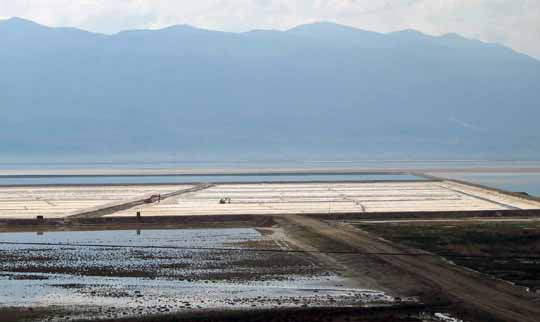
And were parallel to mountains again. These are often topped with snow.
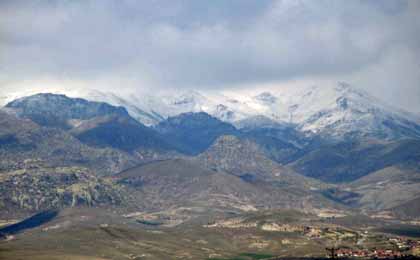

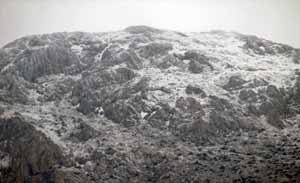
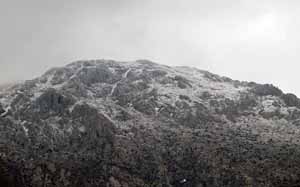
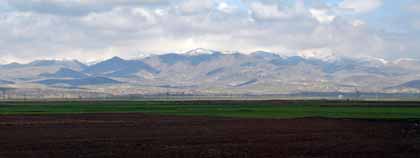
These mountain pictures are terribly difficult to take from a moving buss - the mountains were not all that close. Given the difficulty, I can't help but show as many as possible of the decent shots.
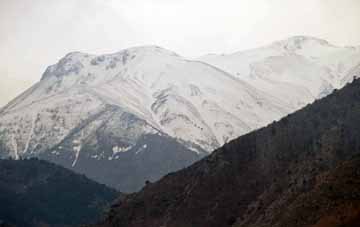
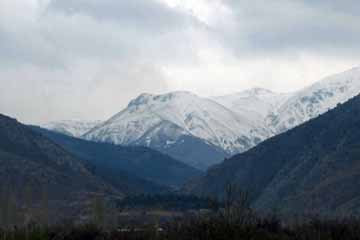
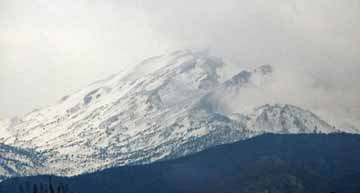
Nearing a town.
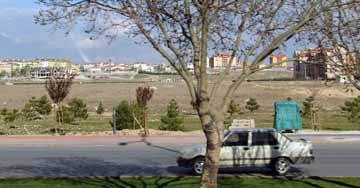
Apartments - some newly built

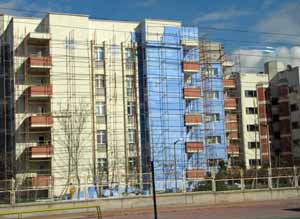

Electric street cars - I guess we call them light rail
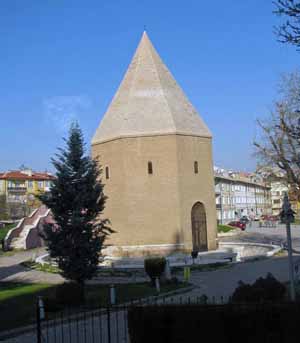 I
don't know what it is - being six-sided and with a moat round it, I'' presume it
to have some religious significance.
I
don't know what it is - being six-sided and with a moat round it, I'' presume it
to have some religious significance.
Next Stop - On to Antalya